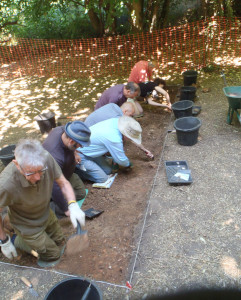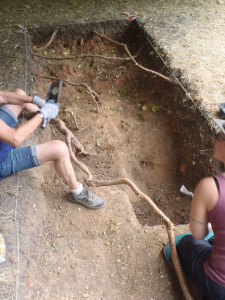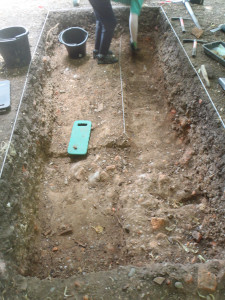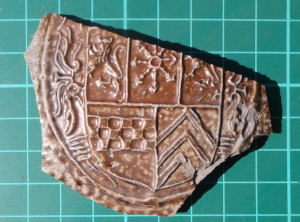15 Jul 2022
Summer Dig - Day 6

Cooler temperatures, at least for the morning and early afternoon, made work a little easier today in Forty Hall, as we draw towards the end of our first week's digging on the site of Elsyng Palace.
Yesterday we had determined that the base of the rubble and brickearth context in trench 1 slopes, potentially very steeply, in a westerly direction away from the lime tree avenue, and we formed a hypothesis that this context represents the cut and fill of the moat which fronted the inner gatehouse of the palace, separating the inner and outer courts.
To test this idea, we opened trench 3 which is in effect a continuation of trench 1, but offset to avoid a tree, to find out whether the rubble and brickearth context rises up again on the possible moat's far side.

Early this morning we finished exposing the surface of this context in trench 3, which was then drawn and photographed, and we then began the task of removing the rubble and brickearth fill, to try and define the cut on which it lies.
This would be hard work even without the heatwave, as the rubble is in places very compact and the context also contains substantial lenses of brickearth which are almost impossible to differentiate from the brickearth layer at its base.
So, although we have made some progress in trench 3, there remains a lot of work to do, especially if the deposit proves to be as deep as it is at the west end of trench 1.
Meanwhile in trench 1, work continued at its eastern end close to the lime tree avenue, to remove the rubble and brickearth context, where it was very thin, and so to define the possible moat's eastern edge.

This is looking quite promising, in that there appears to be a very steep break of slope at the base of the rubble context, which is exactly what we would hope to see mirrored in trench 3 if this feature is indeed a moat.
So far we have only revealed this slope on one half of the trench - excavation is especially slow going in trench 1 because it catches the most sun in the afternoon - but as we neared the base of the 'moat' fill it did begin to produce quite a number of small finds including various animal bones ranging from cow's shoulder blades to dove's toes, various pottery sherds, another wine glass knop, and even a few extremely delicate copper alloy aglets.
Excavation also continued in trench 2, which is now looking less likely, though still not impossible, to produce any structural archaeology.
In fact, the stratigraphy in trench 2 is now beginning to look almost identical to that in trenches 1 and 3, in which case the rubble-rich deposit in trench 2 may also represent the fill of our potential moat.

There remains much more work to be done in trench 2 to clarify this, but the diggers in this trench were rewarded for their hard work and patience this afternoon with today's star find which was a sizeable fragment of a large stoneware jug bearing an elaborate coat of arms.
This is part of a "Bartmann" or "bearded man" jug, which were made in Germany and exported to England throughout the late 16th century. They were so called because they bore the face of an often jolly or sometimes scowling bearded man on the neck of the jug, which later earned them the nickname "Bellarmines" due to the supposed resemblance to an Italian cardinal of the same name.
Bartmann jugs, as in this case, also often bore an armorial medallion as a kind of early product branding, frequently bearing the arms of towns or territories to which, or through which the jugs were exported - in this case the arms are those of the United Duchies of Jülich-Cleves-Berg.
We'll be keeping our eyes peeled in trench 2 for more of this jug, especially the bearded man's face!